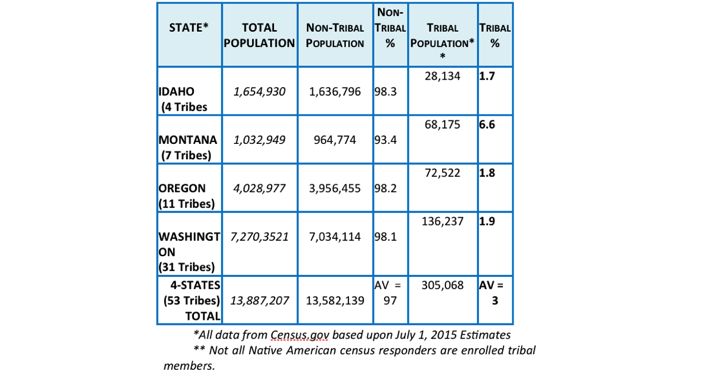
“I do solemnly swear that I will support, protect and defend the Constitution of the United States, and the Constitution of the State of Montana, and that I will discharge the duties of my office with fidelity (so help me God).”
— Constitution of the State of Montana, Article III, Sec. 3
A profound and menacing revolution is underway in each of the 39 states of the United States of America that host one or more federally recognized Indian tribes. Flying completely under the radar of the vast majority of Americans, federal Indian policies of the Obama administration are subverting our constitutional order and successfully transferring vast land holdings and natural resources to corrupt, federally controlled tribal governments. This stealth agenda is replacing the authority and obligations of the various state governments to protect the lives, rights, property, and natural resources of their citizens by illegally and immorally transferring that authority to select tribal governments. This is being done with the full support of state governors, attorneys general, and state legislators, in blatant violation of their oaths of office. Many of these officials are going along with this agenda either because they are receiving sizable donations from tribe-related entities (“bribes from the tribes”), or because they fear being labeled “racist” or “anti-Indian” by the Indian activists and their “progressive” allies in the controlled major media.
The Obama administration is intentionally reversing history and unsettling the West, using Indian reservations and tribal governments as launch pads. It is doing this with the full support of a majority of state executive and legislative representatives, regardless of their political party affiliations. The horrendous consequences of this political path are alarming, to say the least, not only for Americans living in the 39 states directly affected, but for our entire country. While farmers, ranchers, and other rural citizens and small towns are the frontline targets of this stealth agenda, it will dramatically impact all Americans. Urban Americans should also be alarmed by this agenda because it confronts us all with a steadily escalating tax burden, and most particularly because it threatens our nation’s water and food supplies, by placing them in a stranglehold held by dozens of federal agencies (EPA, BLM, USFS, etc.) and tribal governments that have already demonstrated their hostility to liberty and constitutionally limited government.
Tragically, among the most seriously harmed victims in this federal government/tribal government collusion are the vast majority of tribal families that, for the most part, are still living in poverty and squalor. Meanwhile, tribal leaders, the Indian lobbyist industry, and their paid politicians pocket not only huge casino profits, but also the unaudited rivers of cash provided by the U.S. taxpayers via the ever-expanding proliferation of federal programs. The politicians, tribal leaders, and their propagandists adroitly exploit the sympathies of decent Americans and manipulate their feelings of guilt over past wrongs (both real and fictional) against the Indian tribes. But their real goal is building their own wealth and power, not alleviating the plight of the tribal members.
To illustrate the theses in the statements above, I have narrowed the discussion to four Northwestern states: Idaho, Montana, Oregon, and Washington. Statistics in the table below set the framework that suggests that 3 percent of the population within these states (Native Americans) are more substantially served by federal and state elected officials than the other 97 percent of the citizens (non-tribal members), businesses and landowners:

The oath of office at the beginning of this article is from the State of Montana but is similar to oaths of office in other states. The oath is important because, first, it is intended as a solemn oath, and second, it speaks to the constitutional protective duties, both federal and state, that federal Indian policy threatens. For example, tribal sovereignty, federally recognized Indian tribes, and tribal governance over lands within the United States were never contemplated nor incorporated within the four corners of the U.S. Constitution, nor state constitutions, but now the tribes are considered to have powers over federal and state governments, and the citizens they represent.
Politics and perception have created the perilous false reality that tribal sovereignty is superior to the sovereignty of states. The current White House has pounded that perception into the psyche of legislators in all states that host tribes. Of course, enormous tribal campaign contributions and a fear of being called racist if one declines a tribal whim have facilitated this false perception as well.
The framers of our U.S. Constitution prioritized sovereignty in a manner not previously known in governments. The prioritized sovereignty “tree” of the Constitution goes like this:
1. Individual citizen sovereignty (popular sovereignty, We The People).
2. Sovereignty of States (Founders in 13 states formed the federal government).
3. Sovereignty of Federal Government (limited, enumerated powers).
The origin of tribal sovereignty is murky, but the federal “trust” relationship of the federal government over tribes was created by the U.S. Supreme Court in the famous “Marshall Trilogy” cases of the High Court from 1823 to 1830. These cases declared Indian tribes to be quasi-dependent nations, subject to a “trust relationship,” a federal fiduciary obligation to protect the “dependent wards” of the federal government. We must remember, however, as will be discussed later in this piece, that “what the U.S. Supreme Court giveth, the Supreme Court can taketh away” — and it’s getting closer.
As an example of the overpowering influence of tribes in the Northwest, the Columbia River Watershed Management Plan is a good place to start. The watershed is a broad base of tributaries and streams feeding into the Columbia from all four states in the Northwest. The management board that serves as an advisory group directing the management of this federal watershed plan is composed of one representative from each state, and one from each tribe. That means there are four representatives from the four states, and 53 representatives from the tribes. Imagine the influence that state voices have on such a lopsided board. Add major court cases that have provided tribes with half the fish (Boldt Decision of 1974), the Salmon Recovery Project, the Endangered Species Act, and Treaty Rights, and the tribes’ influence is apparent. Unquenchable desires of a large chorus of tribal government demands upon host states are endless and, thus far, unstoppable.
Similar federally sanctioned entities and policies have created a stranglehold on water, natural resources, hunting, fishing, tourism, and recreation in Idaho, Oregon, and Montana, as well. Demonstrating how much the field leans one way is this: Facilitating tribal policy in state capitols includes the rightful opportunity for tribal members as full American citizens, to serve in elected office, although non-tribal persons may not participate in tribal governments.
The true beginning of the replacement of State sovereignty with tribal sovereignty can be credited to a Washington State governor who executed the 1989 Centennial Accord honoring the 100th anniversary of Washington State. That was the benign intent. The precedent-setting hidden agenda was that 1989 was only one year after the Indian Gaming Reorganization Act of 1988, quickly enriching tribes. Washington’s Centennial Accord created a state “trust” relationship with Indian tribes where none existed for any state previously. This Centennial Accord required a tribal office in every state office and required consultation with tribes for every move the state wanted to make thereafter. It also began the double-dipping of tribes, receiving federal subsidies and state tax dollars, too. With burgeoning tax-exempt gaming revenues available, tribes have larger annual operating budgets than the combined budgets of multiple host counties within a reservation boundary.
The Centennial Accord has been replicated by legislatures in many of 39 states that are host to Indian reservations and tribal governments.
This is just a cursory discussion of how a mere 3 percent Native American population in four Northwestern states wields escalating power over the quality of life, taxation increases, limited hunting, fishing, and recreational opportunities of 97 percent of these states’ populations. As more and more taxable parcels are removed from state property tax rolls and placed into tax-exempt “trust” for a tribe, taxes shift upward for 97 percent of the population. States cannot expand their land base; tribal governments can, and do at escalating levels. The current federal administration is delegating its federal authority to tribal governments, giving governance over non-tribal persons and properties, something disallowed under the Indian Reorganization Act of 1934, landmark Supreme Court cases, and federal, state, and tribal constitutions.
The White House has also determined that our national power and energy grid that serves all Americans is good “economic development” for privately governing Indian tribes. It should be noted that self-governing tribes have no obligation to the country’s national or public safety or to non-tribal persons and properties. Tribal sovereign immunity from litigation protects tribal governments from accountability for any harm that may be done when operating critical components of the nation’s public utility power grid.
Now, Montana’s Senator Steve Daines has also proposed S. 3014 to turn national forest management over to tribes with any cultural interest or connectivity. Our mountainous forests are the high sources of the nation’s waters that give life, power, and energy to our country’s economic stability. This is the federal government’s strategy to avoid accountability to Western State legislators insisting that appropriate federal lands be constitutionally “disposed” back to states for management, as was done in the Eastern States upon their statehood.
For years only a few federal agencies served tribal governments such as the Bureau of Indian Affairs (BIA), Health and Human Services (DHHS), and Department of Education (DOE). The Centennial Accord of Washington State, however, became the model for President Clinton’s Executive Order 13084 signed in May 1998, establishing a tribal office in every single federal agency and demanding continuous consultation with tribes, along with inclusion in some 29 federal agency budgets. Subsequent presidents have continued this Executive Order, including Obama’s similar Executive Order 13175, updated in 2009. The quick math: multiply 567 tribes times 29 federal agencies annually funding tribes, which also receive state tax-dollars and billions in tax-exempt gaming revenue.
These cumulative annual dollars are likely equivalent to the annual federal Defense Budget but have never, ever been audited. Federal and state taxpayers are providing annual multi-billions to less than 2 percent of America’s population. Nothing to see here — just unaccountable billions every year. No wonder there is a perception of tribal sovereignty’s superiority over states. These “quasi-dependent wards of the federal government” (“Marshall Trilogy,” 1823) have been entirely funded by federal and state elected officials who have created massive tribal funded programs that have not improved the quality of life for tribal families on Indian reservations in nearly two centuries. In return, these same elected officials are the recipients of much largesse from tribes. Oaths of office are quickly ignored or forgotten when replaced by money and political power.
It’s a vicious circle — Congress provides tribes with tax-exempt gaming revenue, federal subsidies for all basic needs of the tribe, and in return, tribes kick back large money to political parties, incumbents, or candidates that will carry their water. The losers are the annually shrinking state revenues and an ever-shifting burden on taxpayers, who must fund both their state and this monstrous federal Indian policy game. The other tragic losers are enrolled tribal members who have none of the provisions of the Bill of Rights, civil rights, or parental rights over enrollable tribal children, ages 18 and under — yes, Congress gave tribal governments full parental control over tribal children under the Indian Child Welfare Act in 1978.
How and when was this financial vicious circle created? Tribal governments are the only American governments that may write checks to political parties, incumbents, or candidates. This tribal government perk to directly participate in campaign financing came from a three-person unelected Federal Election Commission (FEC) in May of 2000, just before the Bush/Gore election. The Commission’s Advisory Opinion No. 2000-05 to the Oneida Nation of New York deemed the Oneida tribe to be a government for purpose of subsidies and governance, but a “person” for purpose of participating in federal and state elections financing. No court or congressional act created this atrocity. Major tribal money thereafter rolled into both Bush/Gore Presidential campaigns, and has continued ever since in federal and state elections across the country.
A mere FEC “Advisory Opinion” by three unelected federal bureaucrats granted to one tribe, quickly became the law of the land, rolling out across the country. All 567 tribes may act similarly in the country’s elections.
I have dubbed these elected officials who are benefitting from tribal political dollars “coin-operated,” and they have a substantial voice in Olympia, Salem, Boise, and Helena. Naturally, these are also the elected incumbents least likely to put a halt to tribal government funding of candidates and elections — in Congress and state capitols. For far too many elected officials at high and lower levels, appeasing tribes in exchange for cash is their political bread ’n butter, leading to longevity in office if allegiance to the donor is maintained.
So is there an answer to this corruption? Yes, there is one remaining entity relatively unaffected by the “Indian industry,” an entity that has been overturning the federal overreach and the unprecedented expansion of tribalism replacing our constitutional government and state sovereignty. It is the U.S. Supreme Court. Since 2000, the U.S. Supreme Court has issued dozens of rulings to affirm the 10th Amendment and state sovereignty, to declare unanimously that states own their navigable waters and the soils beneath them, to provide individual citizens with standing to sue a tribal government or tribal official, and many other legal tools. The problem? Governors, attorneys general, legislators, counties, and towns are not picking up these legal tools and fighting back for their states and their citizenry, for all the reasons described above. Private citizens can, and do utilize many powerful new rulings, but few have the financial resources to endure the necessary battle.
Very recently, Justice Clarence Thomas put a powerful challenge out to his colleagues on the bench, and to Congress. Here are his clear words:
Congress’ purported [alleged] Plenary Power [all-encompassing] over Indian tribes rests on even shakier foundations. No enumerated power — not Congress’ power to “regulate Commerce … with Indian Tribes,” not the Senate’s role in approving treaties, nor anything else — gives Congress such sweeping authority…. And, until the Court rejects the fiction that Congress possesses plenary power over Indian affairs, our precedents will continue to be based on the paternalistic theory that Congress must assume all-encompassing control over the “remnants of a race” for its own good. [U.S. v. Bryant, No. 15-420, U.S. Supreme Court, 06-13-2016]
If Justice Thomas is correct that Congress lacks plenary power over tribal governments, then Congress may not delegate to federal agencies that which Congress does not have. So where is the constitutional authority of the secretary of interior, the Bureau of Indian Affairs, EPA, etc.? Tragically, tribal governments are the willing pawns and recipients of this costly apartheid system, but the system is entirely and only created by federal and state elected officials who have seemingly switched their allegiance from the states to tribal governments.
The more informed that taxpayers and leaders become about the erosion of constitutional and civil rights protections, the sooner we can recruit public servants who will abide by the solemn oaths they take, winnowing out the “coin-operated” gang that continues to feed at the public trough. Elected officials take no oath to serve tribal governments, but of course they serve all individual American Indians. Perhaps one day the oath of office taken by those we elect to serve all Americans will again be vigorously followed and revered. First, Americans surely should appreciate and value the abundant efforts made over centuries on their behalf, and join with all Americans as One Nation, United. Oaths matter. If not, then 98.8 percent of America’s population remains completely uninformed indentured servants to 1.2 percent of our country’s population, involuntarily funding unconstitutional federal Indian policy.
If the current scheme of federal Indian tribal policy is not reversed, the first states to succumb to this escalating political, jurisdictional, and fiscal program — this intentional takedown of state sovereignty by federal and state elected officials — will be the four states of the Great Northwest. We must not let that happen.
Elaine Devary Willman MPA, authored her first book, Going to Pieces: The Dismantling of the United States of America, in 2005. Her latest book, Slumbering Thunder: A Primer for Confronting the Spread of Federal Indian Policy and Tribalism Overwhelming America, released this year, is a compilation of Willman’s work reflecting experience, projects, and commentaries covering over 25 years of research specific to federal Indian policy government decisions. Her mother and grandmother were enrolled Cherokee members and her husband is of Shoshone ancestry and a direct descendant of Sacajawea.
Willman has lived on three Indian reservations for more than 25 years, and is a recognized expert on federal and tribal government decisions, land use status within Indian reservations, dual-jurisdictions, and constitutional conflicts that impact the rights and lives of tribal members as well as other American citizens. From 2008 until 2015, Willman served the Village of Hobart, Wisconsin, as the Director of Community Development and Tribal Affairs. She currently resides on the Flathead Indian Reservation in western Montana.
Photo of President Obama: AP Images
Related articles:
Oops! SPLC Exposes “Anti-Indian Movement” — Led by Indian
VIDEO interview with Elaine Willman: U.S. Indian Policy Used to Assault Freedom, Expert Says




